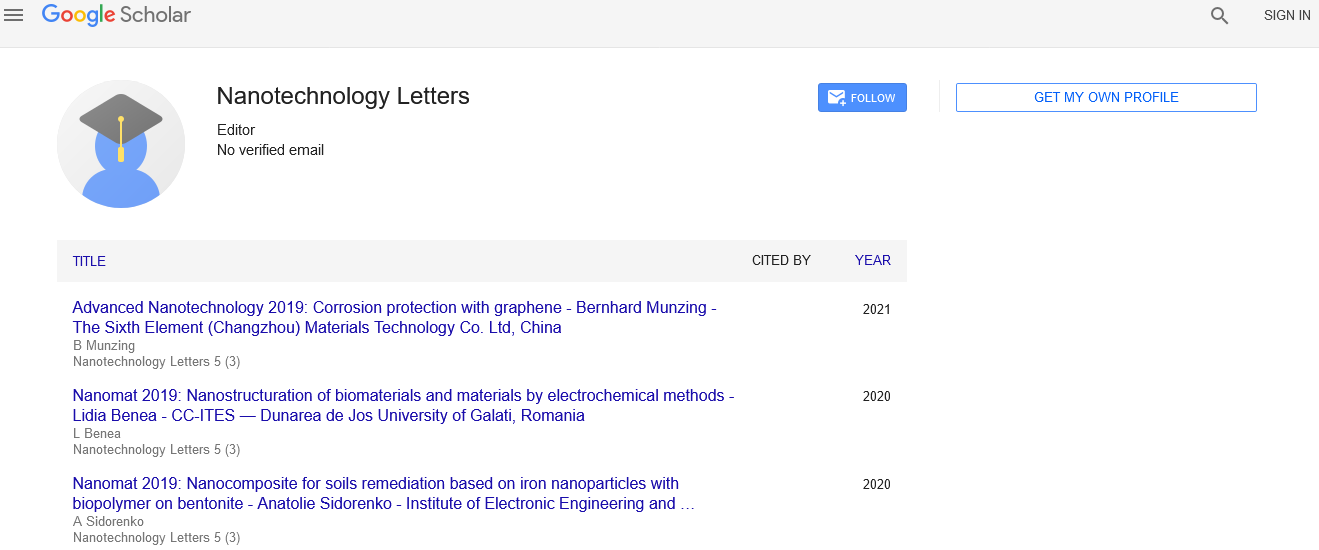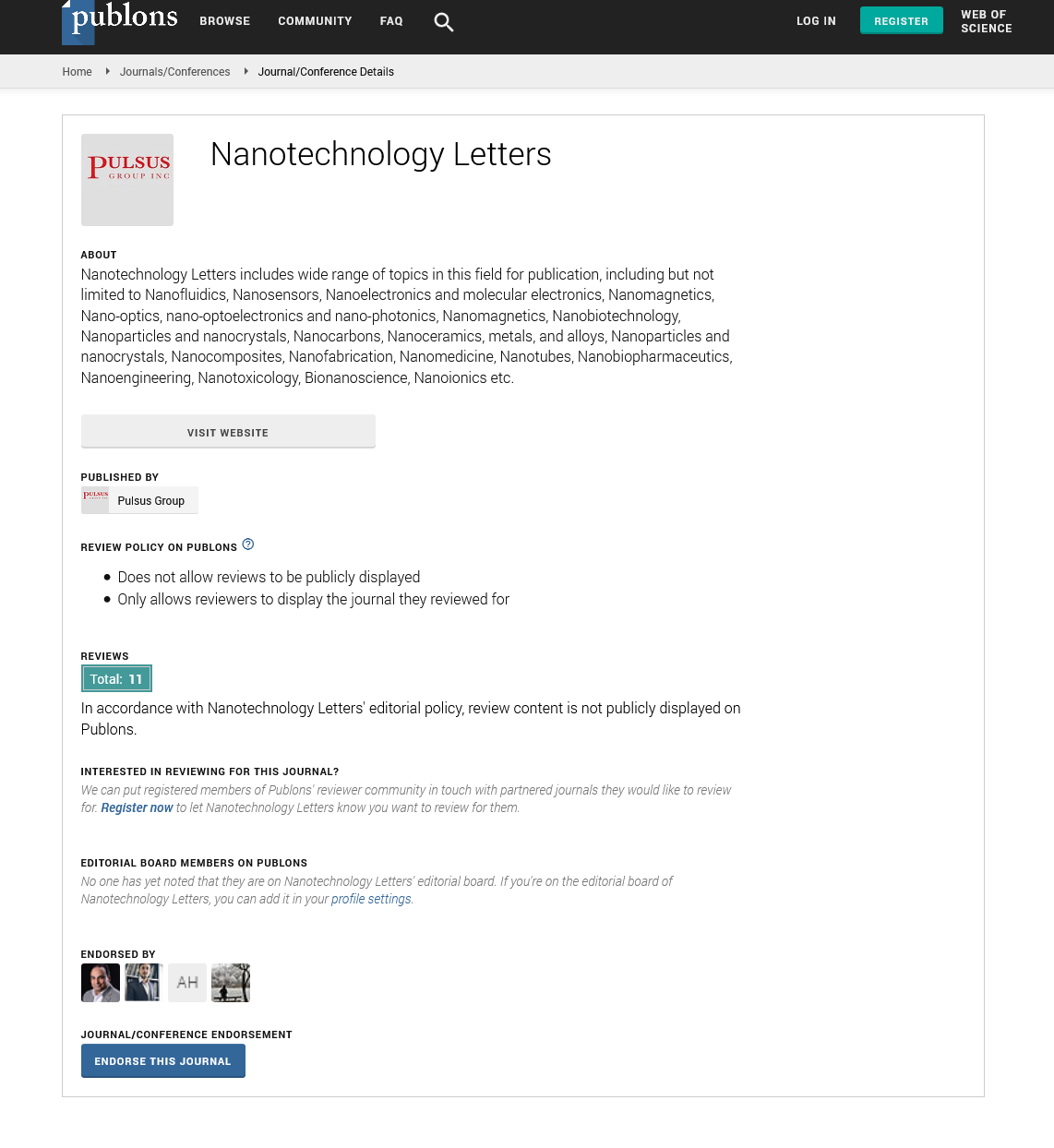Role of nano vaccines in aquaculture
Received: 10-Mar-2023, Manuscript No. pulnl-23-6784; Editor assigned: 14-Mar-2023, Pre QC No. pulnl-23-6784 (PQ); Accepted Date: Mar 26, 2023; Reviewed: 18-Mar-2023 QC No. pulnl-23-6784 (Q); Revised: 22-Mar-2023, Manuscript No. pulnl-23-6784 (R); Published: 27-Mar-2023, DOI: 10.37532. pulnl.23.8 (2) 34-35
Citation: Jhonson.T. Role of nano vaccines in aquaculture. Nanotechnol. lett.; 8(2):34-35
This open-access article is distributed under the terms of the Creative Commons Attribution Non-Commercial License (CC BY-NC) (http://creativecommons.org/licenses/by-nc/4.0/), which permits reuse, distribution and reproduction of the article, provided that the original work is properly cited and the reuse is restricted to noncommercial purposes. For commercial reuse, contact reprints@pulsus.com
Abstract
In aquaculture, there is a critical need for effective vaccines and delivery systems to prevent and manage emerging and re-emerging infectious diseases. The primary challenge has been the difficulty in designing vaccines that can stimulate the desired immune responses. The incorporation of nanoparticles has presented a significant opportunity for creating vaccine delivery systems that excel in precise targeting, ensure antigen stability, and serve as highly effective adjuvants. This review offers a comprehensive examination of various nanoparticle platforms employed in the administration of vaccines for fish.
Key Words
Nanovaccine; Vaccine delivery; Adjuvant; Nanotechnology
Introduction
In recent years, the aquaculture industry has faced growing challenges associated with infectious diseases that can devastate aquatic populations, leading to significant economic losses and environmental concerns. To combat these threats effectively, the development of innovative vaccination strategies has become imperative. One such advancement that has emerged as a potential game-changer is the application of nanotechnology in the form of "nano vaccines" in aquaculture. These nano vaccines harness the unique properties of nanoparticles to revolutionize the way vaccines are designed, delivered, and administered in aquatic species. They offer a promising avenue for improving immunogenicity, enhancing vaccine stability, and achieving targeted delivery, all while minimizing unwanted side effects.
However, it remains challenging to develop effective vaccines for many infectious diseases. There has been a shift in vaccine development approaches, moving away from the traditional use of whole pathogens towards utilizing only the necessary protein and peptide antigens. This transition aims to reduce unwanted side effects, but it has also led to a significant decrease in the immunogenicity of these antigens.
NANO-ADJUVANTS AND DELIVERY SYSTEMS
Nanoparticles employed in vaccine development can be categorized based on their function, serving either as efficient delivery systems or as adjuvants. Delivery system nanoparticles are designed to transport the antigen to targeted immune cells while safeguarding its integrity. Adjuvant nanoparticles, on the other hand, activate specific pathways that enhance antigen uptake and processing, Furthermore, these nanoparticles can be classified as either biodegradable or nonbiodegradable, depending on their ability to break down within a biological system. Generally, other types of nanoparticles used in vaccine research encompass Virus-Like Particles (VPLs), nanoliposomes, Immuno Stimulating Complexes (ISCOMs), nanoemulsions, and metal nanoparticles, as noted by Gregory et al.. It's worth noting that in the development of fish vaccines, the predominant utilization has been centered around polymeric nanoparticles, nanoliposomes, carbon nanotubes, calcium phosphate, and ISCOMs, leaving room for further exploration of other nanoparticle variants.
Inorganic nanoparticles
In the realm of vaccine research, inorganic nanoparticles find application as both adjuvants and potential vaccine delivery systems, owing to their appealing physical and chemical attributes. Among the various inorganic nanoparticles available, examples include carbon, calcium phosphate, gold, silver, silicate, aluminum, titanium, and more. Among these, carbon nanotubes and calcium phosphate have been scrutinized for their potential as vaccine delivery systems in the context of fish vaccines. While inorganic nanoparticles exhibit commendable adjuvant properties and stability, they do come with certain limitations concerning their chemical and physical properties.
In contrast, due to their diverse chemistry, polymeric nanoparticles have emerged as the most widely utilized nanoparticles in vaccine research. To date, extensive exploration has centered around polymeric materials like PLGA and chitosan for the delivery of both viral and bacterial antigens in fish vaccine studies.
Polymeric nanoparticles
Polymeric nanoparticles stand out as the top choice in vaccine research, primarily due to their biodegradable characteristics, biocompatibility, and the wide range of chemical properties they offer. Polymeric nanoparticles possess the capability to either conjugate or encapsulate antigens, whether inside their structure or on their surface. These polymeric nanoparticles can be further categorized based on their source of origin into two groups: naturally derived and synthetically derived polymers.
Naturally derived polymers
Chitosan is a biodegradable polymer derived from various chitinous sources, primarily extracted from the exoskeletons of crustaceans, and therefore qualifies as an environmentally friendly nanoparticle. Its abundance, biodegradability, and biocompatibility make it a highly appealing option for vaccine delivery.
Hyaluronic Acid (HA), on the other hand, is a natural polymer composed of D-glucuronic acid and N-Acetyl-D-glucosamine, found in cartilaginous tissues. It also plays a vital role in immune responses by influencing the movement of white blood cells. Due to its biocompatibility, biodegradability, hydrophilic nature, and abundant presence in nature, HA ranks among the attractive nanoparticle candidates for vaccine delivery.
Synthetically derived polymers
Poly (Lactic-Co-Glycolic Acid) (PLGA) represents a synthetic copolymer synthesized from lactic acid and polyglycolic acid. It serves as a widely employed delivery system in the realm of biomedical research. The utilization of PLGA has garnered approval from both the US Food and Drug Administration (US-FDA) and the European Medicines Agency (EMA) due to its remarkable attributes, including biocompatibility, non-toxicity, and highly biodegradable properties. Following administration, PLGA undergoes hydrolysis, releasing glycolic and lactic acids, which are eventually eliminated from the body through the citric acid cycle
Lipid based biomolecular nanoparticles
In vaccine research, numerous nano-formulations based on biomolecules find extensive use, including liposomes, ISCOMs (Immuno Stimulating Complexes), micelles, and virus-like particles. Among these, liposomes and ISCOMs have been employed for the delivery of vaccines in fish, as noted by Kim et al. [10]. Nanoliposomes, in particular, have gained recognition for their versatility in delivering a wide range of both hydrophilic and hydrophobic antigens due to their unique composition, featuring hydrophilic heads and hydrophobic tails. These nanostructures consist of self-assembled, non-toxic, and biodegradable phospholipids forming an internal aqueous core encapsulated by a lipid bilayer. Additionally, modifying the surface of liposomes is a straightforward process, allowing for the enhancement of immunogenicity and the stimulation of both humoral and cell-mediated immunity.
SAFETY CONCERNS ASSOCIATED WITH NANOPARTICLE TOXICITY IN BIOTECHNOLOGY
While nanoparticles exhibit undeniable potential for a wide range of applications, their inherent characteristics that make them intriguing may also have adverse effects. Given their ability to traverse the Blood-BrainBarrier (BBB), caution must be exercised in their applications, as they can potentially lead to serious complications.Assessing nanoparticle toxicity is a complex task, and predictions cannot rely solely on the toxicity profile of their parent materials because nanoparticles possess distinct properties and are taken up by cells in a manner different from their parent materials.
Recent research aimed at understanding the mechanisms behind nanoparticle toxicity suggests that it can range from cell necrosis to apoptosis induced by Reactive Oxygen Species (ROS), as outlined by Elsaesser and Howard.






